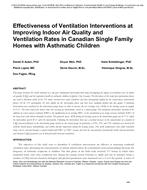Description
This paper describes the results obtained in a two-year randomized intervention field study investigating the impact of ventilation rates on indoorair quality (IAQ) and the respiratory health of asthmatic children in Québec City, Canada. The first phase of the study (pre-intervention phase)was used to determine which of the 111 homes involved were under ventilated and then subsequently eligible for the second phase (interventionphase). Of the 111 participants, 83 were eligible for the intervention phase and these were randomly divided into two groups. Ventilationinterventions were conducted in the intervention group homes in order to increase the air exchange rate (AER) in the heating season by roughly0.15 h-1. The other half of the homes, those not receiving an intervention, served as a control group. The ventilation intervention consisted of theaddition of a heat recovery ventilator (HRV), the modification of an existing HRV, or the installation of an energy recovery ventilator (ERV) ifthe home had a low relative humidity in winter. The geometric mean AER during the heating season in the intervention group was 0.17 h-1 beforethe intervention and 0.34 h-1 after the intervention. Following the intervention there was a marked decrease in the concentration of a number ofIAQ relevant pollutants in the intervention group relative to the control group. In particular, a 43%, 35% and 15% reduction was observed forairborne mould spores, formaldehyde, and carbon dioxide respectively during the heating season. This work demonstrates that under ventilatedhomes can be corrected through a careful retrofit with HRV or ERV systems and that the concentration of potentially health relevant microbialand chemical IAQ parameters can be decreased with increased ventilation.
Citation: IAQ Conference: IAQ 2013: Environmental Health in Low Energy Buildings
Product Details
- Published:
- 2013
- Number of Pages:
- 7
- File Size:
- 1 file , 1.4 MB
- Product Code(s):
- D-2013IAQConf-55




